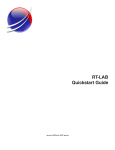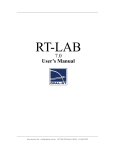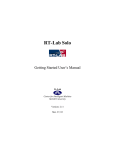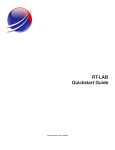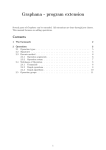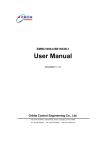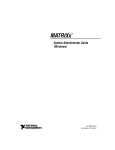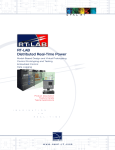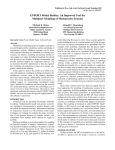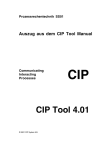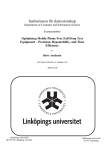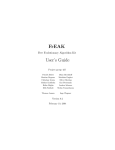Download RT-Lab Solo User`s Manual - Centre for Intelligent Machines
Transcript
RT-Lab Solo Getting Started User’s Manual IA Lab Center for Intelligent Machine McGill University Version: 1.0 Feb. 16, 03 1 Fundamental 1.1 How RT-LAB Solo Works RT-LAB Solo runs on a hardware configuration consisting of Command Station, Compilation Node, Target Node, Communication Links (real-time and Ethernet), and I/O boards. 1.1.1 Command Station RT-LAB software is configured on a Windows NT or Windows 2000 computer called the Command Station. The Command Station serves as the user interface. It allows users to: • Edit and modify models; • See model data; • Run the original model under its simulation software (Simulink etc.); • Generate code; • Separate code; • Control the simulator's Go/Stop sequences. 1.1.2 Target Node Target Node is the computer where simulation runs. For real-time simulation, the preferred operating system for the Target Node is QNX. When there are multiple QNX nodes, one of them is assigned as the Compilation Node. The Command Station and Target Node(s) communicate with each other using communication links, and for hardware-in-the-loop simulations Target Node may also communicate with other devices through I/O boards. The real-time Target Node perform: • Real-time execution of the model’s simulation; • Real-time communication between the nodes and I/Os; • Initialization of the I/O systems; • Acquisition of the model’s internal variables and external outputs through I/O modules; • Implementation of user-performed online parameters modification; 2 • Recording data on local hard drive, if desired; • Supervision of execution of the model’s simulation, and communication with other Nodes. 1.1.3 Compilation Node The Compilation Node is used to: • Compile C code; • Load the code onto each Target Node; • Debug the user’s source code (S-function, User Code Block, etc.). For RT-Lab Solo, Command Station and Compilation Node are referred to the same computer. 1.2 How RT-LAB is Used RT-LAB is an industrial-grade software package for engineers who use mathematical block diagrams for simulation, control, and related applications. The software is layered on top of industry-proven commercial-off-the-shelf (COTS) components like popular diagramming tools MATLAB/Simulink and works with viewers such as LabVIEW and programming languages including Visual Basic and C++. 1.2.1 Designing and validating the model The starting point for any simulation is a mathematical model of the system components that are to be simulated. RT-LAB is designed to automate the execution of simulations for models made with offline dynamic simulation software, like Simulink, in a real-time environment. RT-LAB is fully scalable, allowing users to separate mathematical models into blocks to be run in parallel on a cluster of machines, without subtly changing the model’s behavior, introducing real-time glitches, or causing deadlocks. The detailed steps of accommodating a Simulink model into RT-Lab will be discussed in the following chapters. 1.2.2 Using block diagrams Using block diagrams for programming simplifies the entry of parameters, and guarantees complete and exact documentation of the system being modeled. Once the model is validated, the user separates it into subsystems and inserts appropriate communication blocks. Each subsystem will be executed by Target Node in RT-LAB’s distributed system. The detailed steps of grouping and adding communication blocks will be discussed in the following chapters. 1.2.3 Running Simulations Once the original model has been separated into subsystems associated with the various 3 processors, each portion of the model is automatically coded in C, and compiled for execution by the Target Node. Target Node is commercial PCs, equipped with PC-compatible processors, which operate under a QNX environment. In the QNX environment, the real-time sending and reception of data between QNX nodes is performed through FireWire-type communication boards, typically at 200 Mb/s or 400 Mb/s (depending on the card chosen). More detailed description of Running Your Simulation can be found in the following chapters. 1.2.3.1 RT-LAB simulation When the C coding and compilation are complete, RT-LAB automatically distributes its calculations among the Target Node, and provides an interface so users can execute the simulation and manipulate the model’s parameters. The result is high-performance simulation that can run in parallel and in real-time. 1.2.3.2 Using the Console as a graphic interface Users can interact with RT-LAB during a simulation by using the Console, a command terminal operating under Windows NT. Communication between the Console and the Target Node is performed through a TCP/IP connection. This allows users to save any signal from the model, for viewing or for offline analysis. It is also possible to use the Console to modify the model’s parameters while the simulation is running. 4 2 Building a Distributed Model for RT-LAB Any Simulink model can be implemented in RT-LAB, but some modifications must be made in order to distribute the model and transfer it into the simulation environment. The success of distributed computing with a complex model will depend on the separation of that model into small subsystems synchronized to run in parallel. This should be kept in mind early in and throughout the design process. To build an RT-LAB model, users must modify the block diagram (.mdl file) by: - Regrouping the model into calculation subsystems Inserting OpComm communication blocks Each of these topics is covered within this chapter. After these steps have been completed, RT-LAB begins the compilation process with the regrouped file, separating the model, and generating and compiling the code. The user then sets execution settings, which are covered in the following chapters, after which point the model’s simulation is ready to be executed. This chapter explains the steps required to build an RT-LAB model by modifying your Simulink block diagram to ensure it is properly separated for distributed execution, and maximize the performance: 1. Group the model into subsystems. In this step, you graphically group into subsystems the calculations to be performed by a given CPU. 2. Insert OpComm communication blocks. Communication blocks are part of a block library specifically defined for the RT-LAB interface. They are used by RT-LAB to identify parameters required for communication between the nodes in the hardware configuration. 5 2.1 Building RT-Lab Model The model must be divided into subsystems, each of which represents one node in the real-time network. Two types of subsystems are available: Console: The Console subsystem is the station operating under Windows NT, where the user interacts with the system. It contains all the Simulink blocks related to acquiring and viewing data (scope, manual switch, etc.). Any of these blocks which are required by the user, whether during or after the execution of the realtime model, should be included in the Console Subsystem. There can be only one Console per model. Some Simulink blocks that may be included in the Console Subsystem. Master: The Master computation subsystem is responsible for the model’s real-time calculation and for the overall synchronization of the network. In a system containing Hardware-in-the-Loop (HIL) this subsystem is also responsible for I/O communication. The Master includes Simulink blocks that represent operations to be performed on signals or on I/O icons. There can be only one Master subsystem per model. A demonstration model is supplied with the system. This model has been designed to function properly in the RT-LAB environment, and allows you to review all the steps required to operate the system. Using the information provided in this Manual, you should be able to successfully open the demonstration file, group the model into its required subsystems, set its parameters, and run its simulation on your cluster. 6 2.1.1 Start RT-Lab System You can find the RT-Lab’s shortcut on the desktop of Copper. The name of the icon is “MainControl” Double click on it and the system will be started. The following figure is the Main Control panel. 2.1.2 Open the Demonstration file Click on the button “Open Model”. This enables you the selection of the Simulink file for the model to be processed and executed. The demo file is in the directory C:/ Opal-RT / RT-Lab/ Simulink / models / rtdemo1.mdl. 7 2.1.3 Group the Subsystems The model in the file rtdemo1.mdl has already been properly grouped into subsystem, and is ready to be executed by RT-Lab. The original system can be found in the same directory with the name rtdemo1_init.mdl The following Diagram shows the process of grouping this demo model. 8 2.1.4 Rename the Subsystem For any given model, there must be only one master calculation subsystem, and its name must begin with the prefix SM_. There is also only one Console Subsystem, and its name must begin with the prefix SC_. As you may have seen in the figure of the previous page, the two subsystems have been renamed to SM_Computation and SC_User_Interface. The first one is the Master Computation Subsystem and the second one is the Console Subsystem. 2.1.4.1 To keep in mind when dividing your model A number of conventions must be followed when organizing and naming the subsystems. - All blocks must be included in the subsystems: the top-level model must only show the grouped subsystems. Name the subsystems with a prefix indicating the function of that subsystem: SC_ for Console and SM_ for Master subsystem respectively. - A model must have one Console Subsystem (SC_) and one Master calculation subsystem (SM_). - None of the two types of subsystems (SC_, SM_) may include any other type of subsystem 9 2.1.5 Inserting OpComm Communication Blocks This section explains how and when to insert OpComm blocks into your block diagram, and discusses OpComm parameters that are specific to Simulink users, and those specific to SystemBuild users. You can find the OpComm block in the RT-Lab section of the Simulink Library Browser. The following figure demonstrates these points with an example of shaded OpComm icon inserted in a Simulink model. In the above diagram, you may find there is “new” subsystem with the name “SS_XXX”. The subsystems with “SS_” in their names are Slave Subsystem. For the Solo version of RT-Lab, we do not have to worry about them. If you want to get more detailed information about them, please go to the online help system or check the related description about them in Opal-RT lab’s website at Http://www.Opal-RT.com. 10 2.1.5.1 OpComm blocks Once the model is grouped into Console and computation subsystems, special blocks called OpComm must be inserted into the subsystems. These are simple feed-through blocks that intercept all incoming signals before sending them to computation blocks within a given subsystem. OpComm blocks serve three purposes: 1. When a simulation model runs in the RT-LAB environment, all connections between the main subsystems (SC_, SM_) are replaced by hardware communication links. 2. OpComm blocks provide information to RT-LAB concerning the type and size of the signals being sent from one subsystem to another. 3. OpComm blocks inserted into the Console Subsystem allow you to select the data acquisition group you want to use to acquire data from the model, and to specify acquisition parameters. 2.1.5.2 Rules for inserting OpComm blocks 1. When inserting OpComm blocks into the Console (SC_) subsystem: There must be a maximum of one OpComm block for each Acquisition Group. The Acquisition Group number is specified in the OpComm mask. 2. When inserting OpComm blocks into a Master (SM_) or Slave (SS_) subsystem: There are two kinds of communication associated with Target Node (real-time and non-real-time) but these cannot be sent through the same OpComm block. There must be a maximum of one OpComm block for all real-time communication (communication between Target Nodes), and a maximum of one OpComm block for all non-real-time communication (communication between the Console and a Target Node), for a total maximum of two OpComm blocks in any Master (SM_) or Slave (SS_) subsystem. 11 2.1.5.3 OpComm parameters Double clicking on the OpComm block, you can bring up the following dialog box, which enables you to edit the parameters of OpComm block. Button / Field Function Number of Inports Indicates the number of subsystem input ports (called inports in Simulink) that are to be intercepted by an OpComm block. The inports to a subsystem are simply the signals coming from another subsystem. The block dynamically adjusts the number of its input and output pins according to this parameter. Acquisition Group This parameter, represented by an A on the icon, is relevant only when the OpComm block is inserted into the Console (SC_) subsystem. It has no effect when the OpComm block is inserted into a Master (SM_) or Slave (SS_) subsystem. This parameter specifies the acquisition group number (1, 2, 3, ... 25) for all signals that pass through the OpComm block. Sample Time This parameter is only used for multirate simulation. 12 2.1.5.4 OpComm acquisition parameters The RT-LAB OpComm icon mask offers the following input and output signals. Button / Field Function OpComm acquisition parameters Enables the synchronization algorithm to keep the right signal’s shape. (Input) Enable interpolation Enables the linear interpolation between two values during data loss. (Input) Threshold Defines the threshold difference between the simulation Command Station time and the simulation target time. (Input) Missed data Number of data lost from the simulation platform. Due to network congestion or CPU use, the Console (SC_) is unable to refresh the display with all the data coming from the simulation target platform. In this case, a reception algorithm reacts to the situation to keep the Console synchronized with the simulation target. (Output) Simulation time Time elapsed since the beginning of the simulation’s execution on the target platform. (Output) Simulation offset Time elapsed since the Console started acquiring data from the simulation target platform. (Output) Samples / second Number of samples displayed by the Console between two missed data packets. Can also be used to infer average data displayed. (Output) 13 3 Running your Simulation After distributing the model and generating its associated C code as described in the previous chapters, next in the model implementation process is compilation of the model, and finally its simulation. This chapter explains the procedures involved in compiling, simulating offline, loading your model, executing its simulation, and interacting with the model during simulation. 3.1 Compiling Compiling your distributed model is a fully automated process, initiated by clicking on the Compile button on the Main Control Panel. A dialog box will present four check boxes to be completed before you proceed. Right-click Compile to reset the parameters. When you click Compile, RT-LAB will: • Separate the Model into the SC_, SM_, and SS_ subsystems you defined. The now-grouped block diagram will be split into smaller diagrams, each associated with a different processor. There will be one diagram generated for each SC_, SM_, or SS_ subsystem. • Automatically generate code on the Master and Slave computers. The Simulink sub-models are coded into C language by the MATLAB Real-Time Workshop (RTW) module. RTW also creates a makefile according to a specified template. Since real-time models are executed under the QNX environment, the template used is one designed for compiling under the QNX operating system. During execution of the model’s real-time simulation, the SC_ model can interact with the simulation, since C code is not generated for the Console. • Automatically compile the C code The sub-model files, now coded in C, are then compiled within the QNX environment. Files required for compiling are transferred by Ethernet link from your NT workstation to a workstation operating under QNX. This QNX station compiles all C files for the sub-models, to generate files ready for execution on the Target Node. • Automatically apply panel settings After the code is generated and the model compiled; the user must set execution options before running the simulation. These options, discussed in Chapters 6 through 10, deal with assigning the model to physical CPUs in the network, and setting the configuration parameters through the Configuration panel. 14 3.2 Simulating offline Models can be simulated offline, which is within their Simulink or SystemBuild environments, even after subsystems have been defined and communication blocks inserted. This option is particularly useful for isolating various problems that may exist within the model. During real-time execution, problems can arise at many levels in the system, making it hard to determine the exact source of the problem. By running the grouped model’s simulation off-line, you can investigate any results associated with delays caused by parallel communication, or by the “sample and hold” of I/O communications, without having to worry about problems related to the peripheral hardware (communication boards, memory allocation, bad connections, etc.). Additionally, those using RT-LAB in a HIL context can modify and check the command system offline, which reduces the risk of damage to the hardware. To start simulation execution 1. Start the Main Control Panel by double-clicking on the MainControl.exe icon on your desktop. 2. Select the Simulink file for the grouped model (the .mdl file) by clicking on the Open Model button. 3. Select the target platform, and then click on the Compile button in the Main Control Panel. This automatically starts the following processes: • Separation of the grouped model into subsystems; • C code generation for each subsystem; • Code compilation for the various subsystems for real-time execution. At the end of this step, an executable file is generated for each subsystem of the model. Each file is executed by a Target Node as previously assigned. 4. Assign the generated executables to the real-time cluster’s physical nodes. Click on the Assign nodes button to bring up the list of executables. These constitute the distributed model, and the list of available computing nodes. Each executable can then be assigned to a node in the system. 5. Load the executable files by clicking on the Load button; if the Load/Reset Console Also option is checked, the MATLAB program starts automatically, and the Console Subsystem file is displayed on screen. The RT-LAB display window will appear for the various system nodes, displaying simulation diagnostics between the nodes. 6. Click on Execute to start the system. 15 3.3 Interacting with the model during execution You can interact with the model and change its parameters during real-time execution via the Console Subsystem, located on the Command Station. This feature is useful for adjusting parameters that control model performance: gains, time constants, various limits, etc. Two typical parameter modification blocks, which can be used to interact with the simulation from the Console, are the Manual Switch and the Slider Gain: 16 4 Other Useful resources • Opal-RT Technologies, Inc’s website Http://www.Opal-Rt.com • RT-Lab Knowledge base http://support.opal-rt.com • RT-LAB general block library http://support.opal-rt.com/common/docs/html/api_index.html • QNX Official website Http://www.qnx.com 17 Appendix A: Booting into QNX QNX has been installed on Iron. To boot into QNX, simply restart the computer and Iron will be booted into QNX automatically. You can Login QNX with user name: ntuser and password: ntuser. (These fields are case sensitive.) To go back to Windows, reboot Iron and type 1 when the following message is shown in screen. Press F1-F4 to select drive or select partition: 18 Appendix B: Getting Started with QNX Getting started in QNX is easy. Here are simple steps to work on a QNX machine. Logging in • • Logging in: To log in you have 2 prompts. Both fields are case sensitive. The first prompt will be your username; the second prompt will be your password. After you log into QNX's graphic interface, click the "terminal" button to open a text window for typing QNX commands Directory Commands: • Tell you what directory you are in: pwd To find out what directory you are in, use pwd, which stands for print working directory. • Changing directories: cd directory To change your directory simply use cd directory-name. In QNX, if you are using a full path, use the forward slash. For example, a user named "ialabuser" may have his home directory in /home/ialabuser. Ialabuser can get to his default home directory by simply typing cd. If he wants to be in /tmp, he would type cd /tmp o / means "top directory" o . means "this directory" o .. means "the directory above this directory" (parent) as in cd .. • Making directories: mkdir directory Use the mkdir command to make one or more directories • Make yourself a working directory for your stuff: mkdir /myname • Removing directories: rmdir directory Use the rmdir command to remove one or more directories. File Commands: • Listing files: ls To list files you use the ls command. This simply lists the files in a directory. There are many variations of this command. That is, you can add options to see hidden files, time stamps of files, and permissions. If you ls filename, you will see is filename exists. If filename is actually a directory, you will be able to see the contents of that directory. • ls -l is a "long" format listing with more info Often the first thing one does is do a ls when they log into a system. This allows them to see what files they are using and are working on. 19 • Moving files: mv You move files with the mv command. Simply mv file newfilename. You can move a file to another filename or into a directory. • Copying files: cp You copy files with the cp command. Simply cp file newfilename. You can copy a file to another filename or into a directory. • Removing files: rm You remove files with the rm command. Simply rm file newfilename. You can remove many files at once. Unlike windows, you can NOT back out of a remove. Be certain that you want to remove a file. Attention Please: Do not try to remove the files in the folder ntuser. These may be required for the running of RT-Lab system. • Editing files: vi or pico As each editor of files is vastly different, you will want to learn these separately. Usually, new users will find pico easiest to learn. • QNX comes with the ped editor: ped filename Getting Help: • QNX has no man command - see the html or online reference docs instead. Compiling and running programs: • to compile: qcc yourprogram.c servotogo.c -o executablefilename • sometimes you need to link in a library like -lsocket (no space between -l and socket) • to run it: ./executablefilename Other things: • • • use ftp to transfer files to/from other machines voyager is the web browser ped is the text editor Good luck and have fun with RT-Lab! 20




















